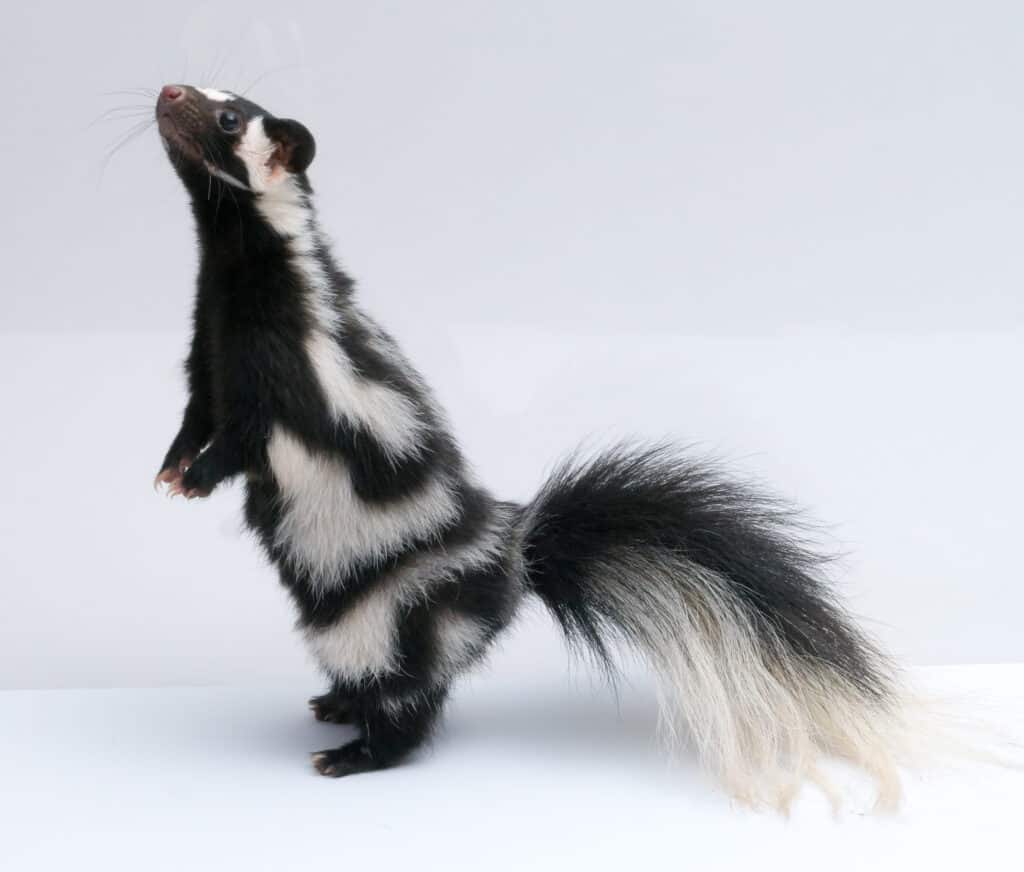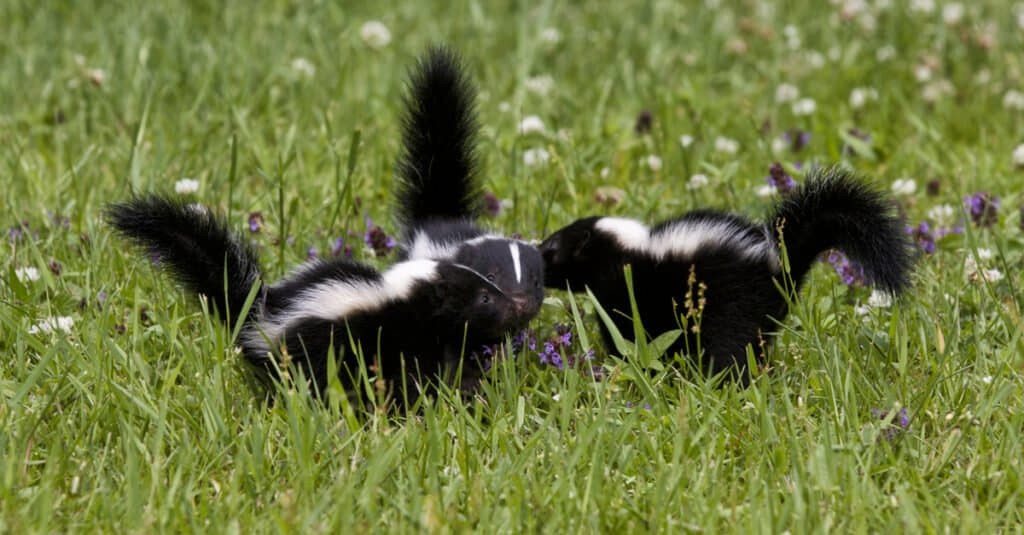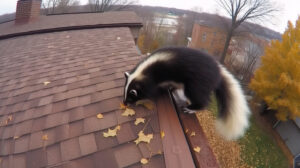Skunks are members of the family Mephitidae, which includes other mammals. There is a broad variety of coloration found on skunks, ranging from black and white to brown, cream, and even ginger. However, all of these hues act as warning markings. Their anal glands are utilized to squirt a material that has a potent and offensive stench when they feel threatened.
Skunks are very closely related to polecats and other weasel species. The Old World stink badger is the skunk’s closest living relative. Skunks inhabit woods peripheries, grasslands, woodlands, and even deserts. They prefer to dwell in abandoned burrows. However, they may settle with caves, huge boulders, and hollow logs if necessary.
Have you ever wondered how many of these stinky little critters are populating our planet? In this article, we will explore the skunk population and how many are left in the world. Let’s go!
How Many Skunks Are Left in the World?

The spotted skunk has white and black lines along its body.
©JayPierstorff/Shutterstock.com
According to studies of wildlife populations, there is typically one skunk for every 10 acres of ideal environment. In addition, there are 13.5 skunks for every square mile of farmland.
There are a total of 12 species in the skunk family. Ten of those species are native to the Western Hemisphere. Skunk species are divided into four genera: Conepatus, Mephitis, Mydaus, and Spilogale. Skunks come in four different species, all of which are found in either North or South America. Skunks with stripes, hoods, pig noses, and spots fall under this category.
The most common skunks in North America are terrestrial creatures that can adapt to many different environments. Thirteen different subspecies of striped skunks exist. From northern Mexico to southern Canada, you can find homes for striped skunks. It can be found in every single state in North America.
Is The Skunk Population Endangered?
Some states have even designated the Eastern spotted skunk as endangered. However, the federal government hasn’t yet designated this species as endangered, and there are no restrictions on the quantity that can be trapped or hunted in some states, including Tennessee. The International Union for the Conservation of Nature states that there are no skunk species in danger of extinction. However, they do face threats from a number of different sources.
The eastern spotted skunk was once common throughout the East, Midwest, and South, but is now nearly extinct in those regions. Its population may have dropped by as much as 99 percent during the past 70 years. It may be extinct in the wild within a decade, and it is probably extinct in most of its natural habitat. The reason why is still a mystery, although some believe it’s brought on by agricultural practices that remove the ground cover.
Are Any Skunks Already Extinct?

Skunk-like mammals lived earlier than previously assumed, as suggested by the discovery of a fossil of a dinosaur-era species in Chilean Patagonia.
©Debbie Steinhausser/Shutterstock.com
The fossil of a skunk-like dinosaur-era animal found in Chilean Patagonia supports the idea that these mammals existed earlier than previously thought. German skunk fossils date back 11-12 million years. Genetic evidence suggests that this family’s ancestors initially appeared 30–40 million years ago when creatures with skunk-like fangs appeared.
Are Skunks Beneficial to Our Ecosystem?
Skunks are actually a vital part of our ecosystems. They are beneficial to farmers, gardeners, and landowners because they consume a wide variety of pests that would otherwise be a nuisance. Skunks gorge themselves on the insects, moles, and grubs that would otherwise eat your prized plants if they weren’t stopped in their tracks by the predators.
They like consuming harmful insects that feed on plants and cause damage, such as Japanese beetles, cutworms, and hornworms. In addition, during the warmer months, you won’t have to be concerned about being attacked by rattlesnakes if you have a skunk living in your yard or around your home.
What Would Happen If Skunks Went Extinct?
Skunks support our farmers enormously and play an important part in our ecosystem. In particular, spotted and striped skunks eat garden pests and keep the bug population on farms under control, ensuring that people have access to safe and nutritious food.
Despite the fact that skunks have a bad reputation, they are actually quite docile creatures who only resort to using their spray if absolutely necessary. In the face of danger, these near-sighted mammals will first try to flee, then stand their ground, raise their tail as a warning, and ultimately spray. It takes skunks many days to replenish their spray supply (which only holds around four tablespoons), leaving them defenseless. Ultimately, skunks pose no risk, yet they are in serious danger of extinction.
The photo featured at the top of this post is © Yasmins world/Shutterstock.com
Thank you for reading! Have some feedback for us? Contact the AZ Animals editorial team.





